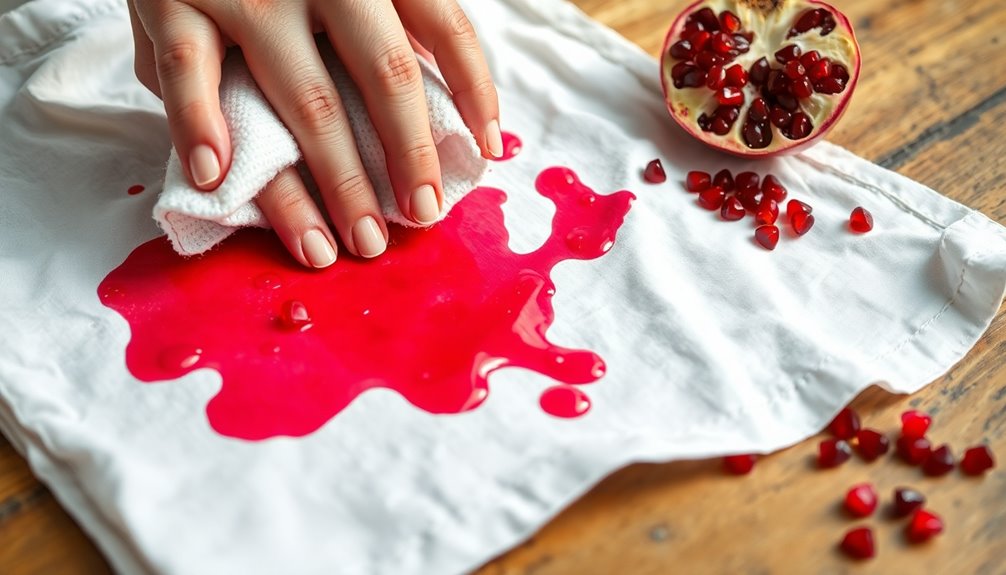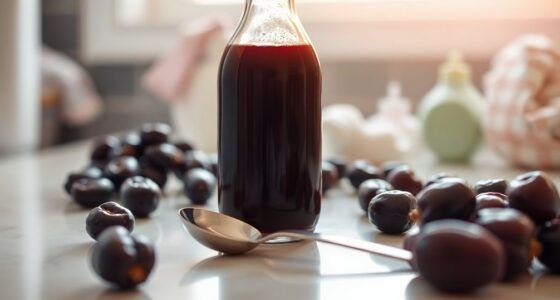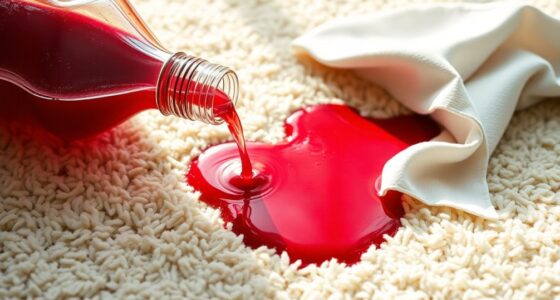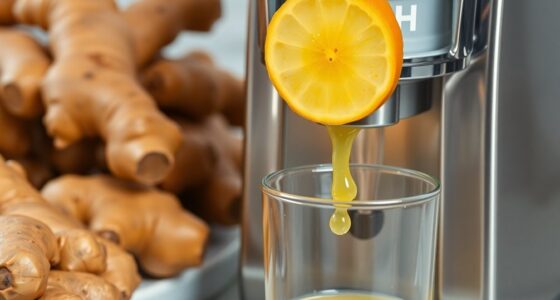To get pomegranate juice out of clothes, act fast! Rinse the stain with cold water immediately. Apply liquid laundry detergent directly on the affected area and let it sit for about five minutes. If the stain is older, soak the garment in cold water with detergent for 30 minutes first. Always wash using cold water to prevent setting the stain. If it persists, repeat the process or try oxygen-based bleaching solutions. More tips can help you tackle stubborn stains.
Key Takeaways
- Act quickly by rinsing the stain with cold water to dilute the pomegranate juice as soon as possible.
- For fresh stains, apply liquid laundry detergent directly onto the stain and let it sit for five minutes.
- For old stains, soak the garment in cold water for 30 minutes after applying detergent, then rinse thoroughly.
- Always wash stained clothes using a cold water setting to prevent setting the stain permanently.
- If the stain persists, repeat the treatment process or use color-safe, oxygen-based bleach for tougher stains.

Pomegranate juice can quickly turn your favorite shirt into a colorful canvas, but don't panic! You can effectively remove that stubborn stain with a few simple steps. The key is to act fast. As soon as you notice the juice splatter, head to the sink and rinse the affected area with cold water. You want to dilute the stain before applying any treatment to minimize its effect. The quicker you can get to it, the better your chances of saving your garment.
Next, if the stain is fresh, grab a liquid laundry detergent, like Ariel Matic, and apply it directly onto the stain. Make sure to let it sit for about five minutes before you proceed to washing. This step is crucial for breaking down the pomegranate juice's pigments, which are known for being particularly stubborn.
Always pay attention to the fabric care label on your garment, as it will provide guidance on the appropriate washing methods and temperatures.
For those old stains that have had time to settle in, you'll need to take a slightly different approach. Start by soaking the stained garment in cold water for 30 minutes after applying your detergent. This extra soaking time helps loosen the pomegranate juice particles, making them easier to remove during the washing process.
Once the soaking period is over, rinse the garment thoroughly to ensure most of the stain is gone before laundering it as you normally would.
When you're ready to wash, use a cold water setting. Hot water can sometimes set the stain, making it nearly impossible to remove. By sticking to cold water, you help prevent any remaining juice from becoming permanently embedded in the fabric.
After washing, always check the stained area to ensure you've completely removed the stain before you toss the garment into the dryer. Heat from the dryer can set any remaining stain, which could spell disaster for your favorite shirt.
If the stain persists after washing, repeat the pre-treatment process. You might also consider using a biological pre-soaking agent or a color-safe, oxygen-based bleaching product.
These options can work wonders for breaking down tough stains like pomegranate juice. Remember, patience is key. You may need to try a couple of different methods to fully remove the stain, but don't give up!
Frequently Asked Questions
Does Pomegranate Juice Come Out of Clothes?
Yes, pomegranate juice can come out of clothes if you act quickly.
Rinse the stained area with cold water immediately to dilute the juice.
Then, apply a liquid detergent directly to the stain and let it sit for a few minutes.
If the stain persists, consider using a biological pre-soaking agent or an oxygen-based bleach.
Just remember, repeated treatments might be necessary to fully remove stubborn stains.
Don't let it set!
Does Oxiclean Remove Pomegranate Stains?
Imagine a warrior battling a fierce dragon—this is you against pomegranate stains. OxiClean's your trusty sword, designed to slice through tough stains with precision.
When you mix it with water and let your garment soak, you're preparing for battle. Just remember to follow the instructions for the best results.
Test it on a hidden area first, and with timely action, you'll triumph over those stubborn stains. Victory awaits!
How to Remove Pomegranate Sauce Stains?
To remove pomegranate sauce stains, start by rinsing the stained area with cold water immediately. This helps dilute the sauce and prevents it from setting.
Next, apply a biological pre-soaking agent directly to the stain.
After that, wash the garment in the hottest water temperature recommended on the care label.
If the stain's still there post-wash, don't dry it—repeat the treatment to increase your chances of complete removal.
How to Remove Pomegranate Juice?
When you're faced with a pomegranate juice stain, don't panic; act quickly. Rinse the stained area with cold water to dilute it, then apply a liquid detergent directly onto the stain. Let it sit for five minutes before washing.
For older stains, flush with cold water, soak in a detergent mix for thirty minutes, and rinse well.
Always check the fabric care label, and avoid drying until the stain's completely gone.
Conclusion
In the battle against stubborn pomegranate juice stains, don't lose hope. Picture the vibrant red droplets fading away, leaving your clothes as pristine as the morning dew. With a bit of patience and the right techniques, you can restore your favorite garments to their former glory. Remember, each successful stain removal not only brightens your wardrobe but also fills your heart with satisfaction. So roll up your sleeves and reclaim your clothes, one juicy challenge at a time!
Cindy thoroughly researches juicing trends, techniques, and recipes to provide readers with practical advice and inspiration. Her writing style is accessible, engaging, and designed to make complex concepts easy to understand. Cindy’s dedication to promoting the advantages of juicing shines through her work, empowering readers to make positive changes in their lives through the simple act of juicing.











